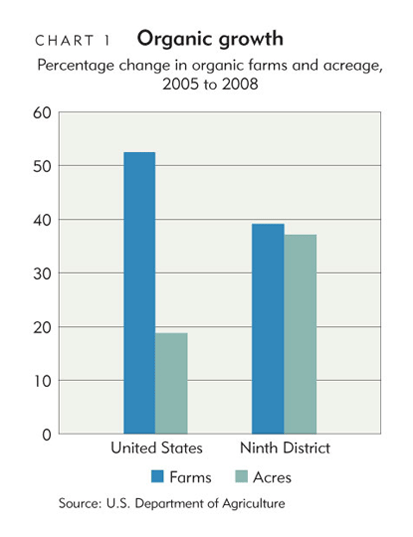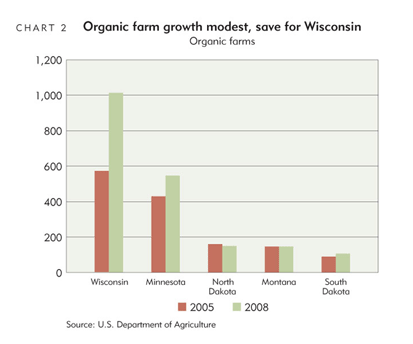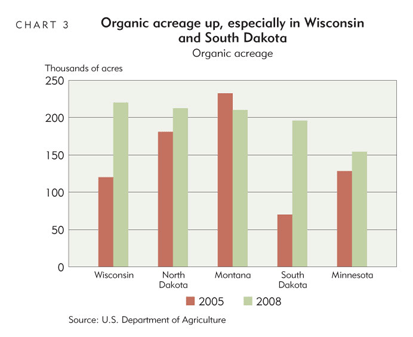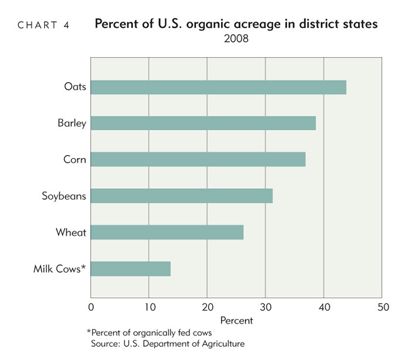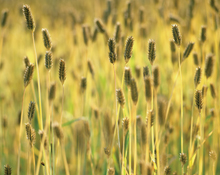
When you think of organic agriculture, you probably imagine yourself eating leafy greens and other vegetables you buy for a salad. For that reason, you might not think that Ninth District states, which specialize in major commodity crops and livestock, have a large role in organic production.
But, in fact, the Ninth District is a major organic producer, and its organic footprint continues to expand as more farms undergo the certification process that ensures that their practices exclude or strictly limit the use of synthetic fertilizers and pesticides, plant growth regulators, livestock antibiotics, food additives and genetically modified organisms.
Although it remains a small component of total U.S. agriculture (0.6 percent in 2008), organic farming has been expanding both nationwide and in Ninth District states. For example, the number of organic farms in district states increased by almost 40 percent from 2005 to 2008, slightly lower than the 52 percent growth across the country, according to the most recent data from the U.S. Department of Agriculture (USDA) (see Chart 1).
Wisconsin was the only district state to see higher growth (75 percent, or 436 farms) than the national average (see Chart 2). In fact, Wisconsin ranks in the top five states for the number of farms producing organic dairy, beef, poultry, other livestock, crops, vegetables and melons. Wisconsin’s organic farms are diverse in both size and crop, but they are on average smaller than similar farms in other states, which likely contributes to its larger numbers.
Conversely, the rate of acreage certified as organic grew faster in district states during this period—37 percent compared with 19 percent nationwide (see Chart 3). In terms of total organic acreage, all five district states ranked in the top 11 states in 2008. Growth was stronger in pastureland and rangeland (63 percent) than in cropland (28 percent), but all district states rank high in both categories.
Districtwide acreage growth was largely driven by two states. Total organic acreage in South Dakota almost tripled, and roughly doubled in Wisconsin. South Dakota also saw organic pastureland and rangeland increase ninefold, or 100,000 acres, during this three-year period. This growth is perhaps due in part to the addition of about 3,300 organic beef cows (a 500 percent increase) over the same period.
Montana is the district outlier, having negative growth both in the number of certified organic farms and in acres. These data are based on information from USDA-accredited state and private organic certifiers. But certifications by the Montana Department of Agricul-ture—the state certifier—actually increased by 44 farms (67 percent) between 2005 and 2008.
The Montana department also suggested that the decrease in certified acres may have resulted from a number of farms dropping certified acres never put into use. For example, one operation certified 36,000 acres of organic pastureland for several years in case it ever sold some of its herd, but eventually dropped the organic designation. The drop represented a significant decrease in the total certified acreage, but did not affect production.
The new bread and feed basket
The district’s biggest organic footprint is in grains, producing 30 percent of the U.S. total (see Chart 4). Between 2005 and 2008, the district increased production of almost all grain crops with the front-runner being corn. Acreage increased by 61 percent, and each district state saw an increase in acres of at least 19 percent.
Multiple drivers apparently are behind this trend in organic corn and other grains. The USDA reported, for example, that breads and grain products were a leader in organic food and beverage introductions.
But probably more relevant, especially for district states, is a growing organic livestock market. Demand for organic livestock and poultry has been increasing in the country as a whole, and also in the district. These animals require organic feed in order to be certified USDA organic, and corn often makes up a majority of livestock diets. District states already specialize in feed production for conventional uses, and it makes sense that they would play a prominent role in the growing organic feed market.
From a fairly small base in 2005, the organic livestock market has witnessed robust growth. Organic cows, pigs and sheep increased by 142 percent in the United States between 2005 and 2008, while chickens and other poultry increased by a comparatively paltry 13 percent. Trends were somewhat the opposite in the district, with chickens and poultry seeing very strong growth (147 percent), while organic cows, pigs and sheep grew by 72 percent.
Wisconsin is the district’s clear leader in both organic livestock categories, ranking second nationally in livestock and fifth in poultry in 2008. Minnesota is the next-largest producer in the district, but has only a fraction of the animals that Wisconsin has in both categories.
Overall, the outlook for the organic food industry is positive, but there are challenges, including a shaky economy that has pushed some consumers to cheaper foodstuffs. Organics are also battling increased competition from foods labeled “natural”—a less expensive and less regulated classification.
According to a recent Nutrition Business Journal article, price inflation in the organic industry is expected to lag that in the conventional industry (where prices have already started to increase). This will cause the price premiums for organics to shrink and should help bring back consumers lost to higher prices during the recession.
The outlook for organic livestock is also positive, as demand for organic dairy and meat is expected to increase. In fact, the Nutrition Business Journal predicts that the meat, poultry and seafood category will be a “bright spot” for organics in 2010.



